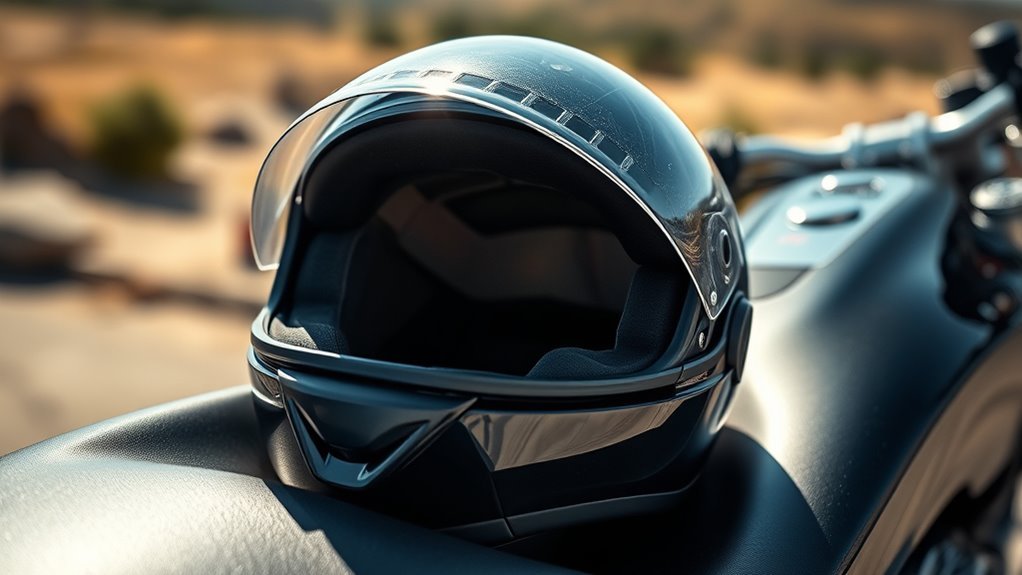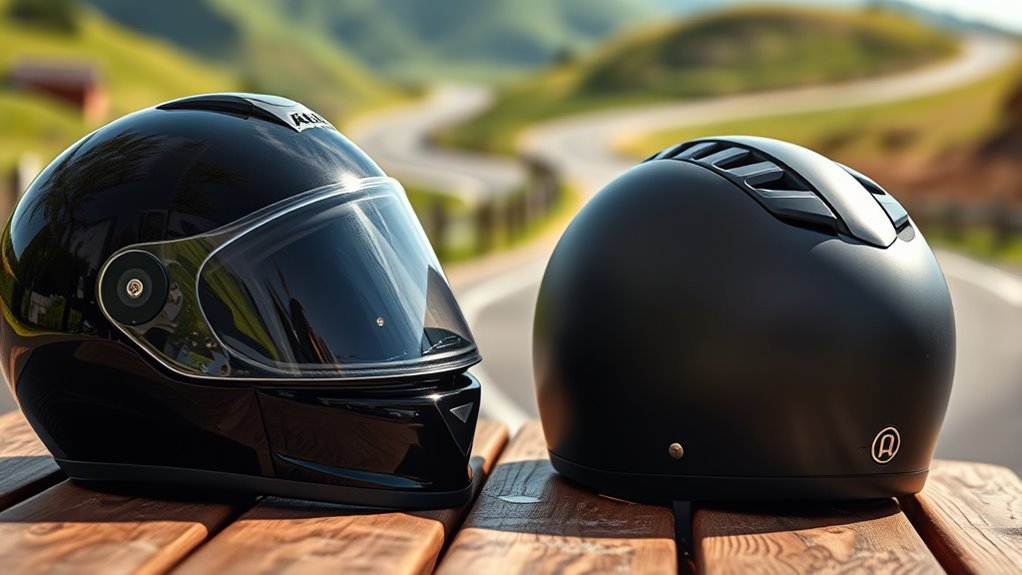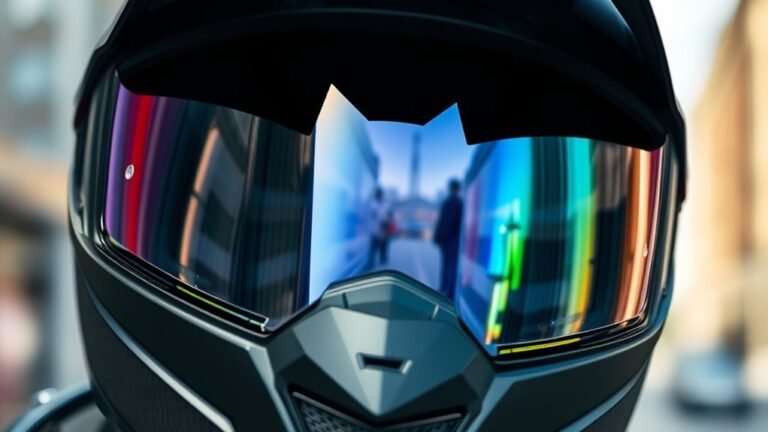Pros and Cons of Open-Face Helmets
Open-face helmets offer lightweight designs, enhanced visibility, and superior comfort. They allow for better airflow and communication, making your rides more enjoyable. However, they come with drawbacks, including limited safety standards and exposure to the elements, which can increase the risk of injuries and fatigue. While the style and comfort can be enticing, it’s important to evaluate those against the potential risks. There’s more to reflect on if you’re exploring the balance between comfort and safety.
Advantages of Open-Face Helmets

When you consider the benefits of open-face helmets, you’ll find that they offer a unique blend of safety and comfort. One of the primary advantages is their lightweight design, which makes them an excellent choice for riders seeking freedom on the road. Unlike heavier full-face helmets, open-face options reduce neck strain, allowing for longer rides without discomfort. Additionally, open-face helmets come in various stylish options, catering to personal aesthetics while ensuring a sense of individuality. This combination of comfort and style enhances your riding experience, allowing you to express yourself while prioritizing safety. Ultimately, choosing an open-face helmet can provide a liberating feel, letting you enjoy the ride while remaining adequately protected.
Enhanced Visibility and Awareness

How can enhanced visibility and awareness improve your riding experience? Open-face helmets promote a wider field of vision, allowing you to better perceive your surroundings. This increased visibility can greatly elevate your safety perception and situational awareness, essential for traversing busy roads.
- You’ll spot potential hazards sooner.
- It’s easier to communicate with fellow riders or pedestrians.
- You can enjoy the scenery without obstruction.
- Improved awareness of other vehicles enhances decision-making.
- It fosters a sense of freedom, connecting you more with the ride.
Ultimately, these factors contribute to a more enjoyable and safer riding experience, making open-face helmets appealing for those who value both safety and the thrill of the open road.
Comfort and Ventilation

When considering comfort and ventilation in open-face helmets, you’ll find that superior airflow can greatly enhance your riding experience. These helmets often incorporate features designed for temperature regulation, which can help keep you cool during warm rides. Ultimately, a higher comfort level can contribute to longer, more enjoyable journeys on the road.
Superior Airflow Benefits
Open-face helmets offer significant airflow advantages, making them a popular choice among riders seeking comfort and ventilation. The design promotes airflow dynamics that enhance your riding experience, ensuring you stay cool during long rides. Here are a few benefits of superior airflow:
- Improved breathability helps reduce heat build-up.
- Fresh air circulation boosts focus and alertness.
- Reduced fogging, enhancing visibility.
- Lightweight construction makes them comfortable for extended use.
- Minimalistic design allows for a sense of freedom and connection with the environment.
These factors contribute to a more enjoyable ride, allowing you to feel the wind and embrace the open road. With better ventilation, you can focus on the journey ahead without being distracted by discomfort.
Enhanced Comfort Level
One of the key advantages of open-face helmets is their ability to enhance comfort levels during rides. With their lightweight design, you’ll hardly notice you’re wearing one, allowing for a more liberated experience on the road. Additionally, the open-face structure facilitates easy maintenance, making it simple to keep your helmet clean and fresh.
| Feature | Benefits | Considerations |
|---|---|---|
| Lightweight Design | Reduces fatigue | May lack full coverage |
| Easy Maintenance | Quick cleaning | Limited protective features |
| Enhanced Comfort | Better airflow | Less insulation |
Ultimately, the comfort of an open-face helmet caters to those who value freedom while ensuring a smooth ride.
Temperature Regulation Features
While enjoying a ride, maintaining an ideal temperature can greatly impact your overall comfort, especially in varying weather conditions. Open-face helmets are designed with features that enhance temperature control and airflow efficiency. Here are some key aspects to evaluate:
- Ventilation Ports: Allow air to flow freely, reducing heat buildup.
- Moisture-Wicking Liners: Help manage sweat, keeping you dry and comfortable.
- Adjustable Airflow: Some models let you customize ventilation based on your preferences.
- Lightweight Materials: Reduce bulk and promote better airflow.
- Compatibility with Visors: Options for additional sun protection without compromising circulation.
Understanding these features can help you choose a helmet that not only protects but also keeps you comfortable during your rides.
Drawbacks of Open-Face Helmets
Although many riders appreciate the freedom and visibility that open-face helmets provide, there are several drawbacks to contemplate. One major concern is their limited ability to meet certain safety standards compared to full-face options. In various riding conditions, such as high speeds or adverse weather, the open design can expose you to debris and wind, which can be distracting or even hazardous. Additionally, without a chin guard, you may feel more vulnerable to impacts. The airflow that feels liberating can also lead to increased noise, potentially affecting your concentration on the road. While the allure of freedom is undeniable, it’s crucial to weigh these factors against your safety and comfort while riding.
Limited Protection in Accidents
When considering open-face helmets, it’s important to recognize their limitations in accident scenarios. They offer reduced impact coverage compared to full-face helmets, exposing your face to potential injuries. Additionally, the lack of a windshield can increase vulnerability to wind and debris, further compromising your safety.
Reduced Impact Coverage
Open-face helmets, despite their popularity for offering a sense of freedom and visibility, present a significant drawback regarding reduced impact coverage. While they meet some safety standards, the protection they provide is limited compared to full-face alternatives. This can lead to serious injuries in the event of an accident due to the exposed areas.
- Limited coverage for the chin and face
- Often lighter, but may compromise safety
- Helmet materials may not absorb impact as effectively
- Less aerodynamic, potentially increasing head movement in crashes
- Reduced protection against environmental factors
Ultimately, if you prioritize freedom, consider how much protection you’re willing to sacrifice. Understanding the trade-offs can help you make more informed choices about your safety on the road.
Facial Vulnerability Risks
While the allure of open-face helmets lies in their enhanced visibility and comfort, they leave riders particularly vulnerable to facial injuries during accidents. Unlike full-face helmets, open-face designs provide minimal protection for your face, exposing it to potential impacts and abrasions. In the event of a crash, the risk of sustaining serious facial injuries, such as fractures or lacerations, greatly increases. Although these helmets may meet certain safety standards, they often fall short in safeguarding the facial area compared to their full-face counterparts. Riders who prioritize freedom and visibility should evaluate these vulnerabilities against the potential consequences of inadequate protection, especially in high-risk situations. Ultimately, it’s crucial to reflect on how much protection you’re willing to sacrifice for comfort.
Limited Windshield Protection
The lack of a full windshield in open-face helmets can considerably compromise rider safety during accidents. While they offer a sense of freedom and airflow, this design flaw may leave you vulnerable to serious injuries. Unlike full-face helmets, which provide extensive protection, open-face options often lack sufficient barrier against impacts. Consider these factors when evaluating protection alternatives:
- Limited facial coverage increases risk of injury.
- Windshield design may not deflect debris effectively.
- Exposure to the elements can impair visibility.
- Inadequate protection during high-speed collisions.
- Reduced structural integrity compared to full-coverage helmets.
Ultimately, while open-face helmets enhance your riding experience, weighing their limited windshield protection against potential risks is essential for your safety on the road.
Weather Exposure and Elements
When riding with an open-face helmet, you’re more exposed to the elements than you would be with a full-face option. This exposure can greatly impact your comfort and safety. While the open design allows for greater airflow and a sense of freedom, it also means you’re vulnerable to sun exposure, which can lead to sunburn and fatigue during long rides. Additionally, the wind chill effect can be pronounced, especially at higher speeds or in colder weather, making your ride less enjoyable. You might find that the lack of a full-face shield increases your awareness of the environment, but it also comes with trade-offs. Ultimately, weighing these factors is essential for making an informed decision about your helmet choice.
Frequently Asked Questions
Are Open-Face Helmets DOT Approved?
Yes, open-face helmets can be DOT approved, as long as they meet the necessary safety standards. You’ll find that many manufacturers design these helmets with features like reinforced chin straps and impact-resistant materials to enhance protection. However, it’s vital to check for the DOT certification sticker inside the helmet. Balancing freedom and safety is essential, so always prioritize your well-being while enjoying the open road. Choose wisely for your riding adventures!
Can I Wear Glasses With an Open-Face Helmet?
Yes, you can wear glasses with an open-face helmet, but you might encounter some comfort issues. Many riders find that certain helmet designs allow for better glasses compatibility than others. It’s essential to try on different helmets while wearing your glasses to guarantee a good fit. Look for models with ample space around the temples and consider adjustable padding to enhance comfort, allowing you to enjoy your ride without compromising your vision.
How Do I Properly Clean an Open-Face Helmet?
How often do you think about the cleanliness of your gear? To properly clean an open-face helmet, start by removing the inner liner and washing it separately with mild soap. Use a soft cloth and gentle cleaning techniques on the outer shell, avoiding harsh chemicals. Don’t forget to dry it thoroughly before reassembling. Regular maintenance tips include inspecting for damage and storing it in a cool, dry place to prolong its life.
What Brands Are Popular for Open-Face Helmets?
When you’re looking for the best open face helmets, brands like Bell, Shoei, and Arai stand out for their quality and helmet features. Bell offers stylish designs with excellent ventilation, while Shoei is known for its comfort and safety standards. Arai focuses on superior fit and craftsmanship. Each brand caters to riders seeking freedom on the road, ensuring you get both protection and an enjoyable riding experience without compromising style.
Are Open-Face Helmets Heavier Than Full-Face Helmets?
Open-face helmets can often feel like a feather compared to full-face helmets, which can sometimes weigh you down. When it comes to weight comparison, open-face options are generally lighter, allowing for a greater sense of freedom while riding. However, this lighter design often sacrifices some safety features found in full-face models. Ultimately, it’s essential to balance your desire for lightness with the level of protection you want on the road.






